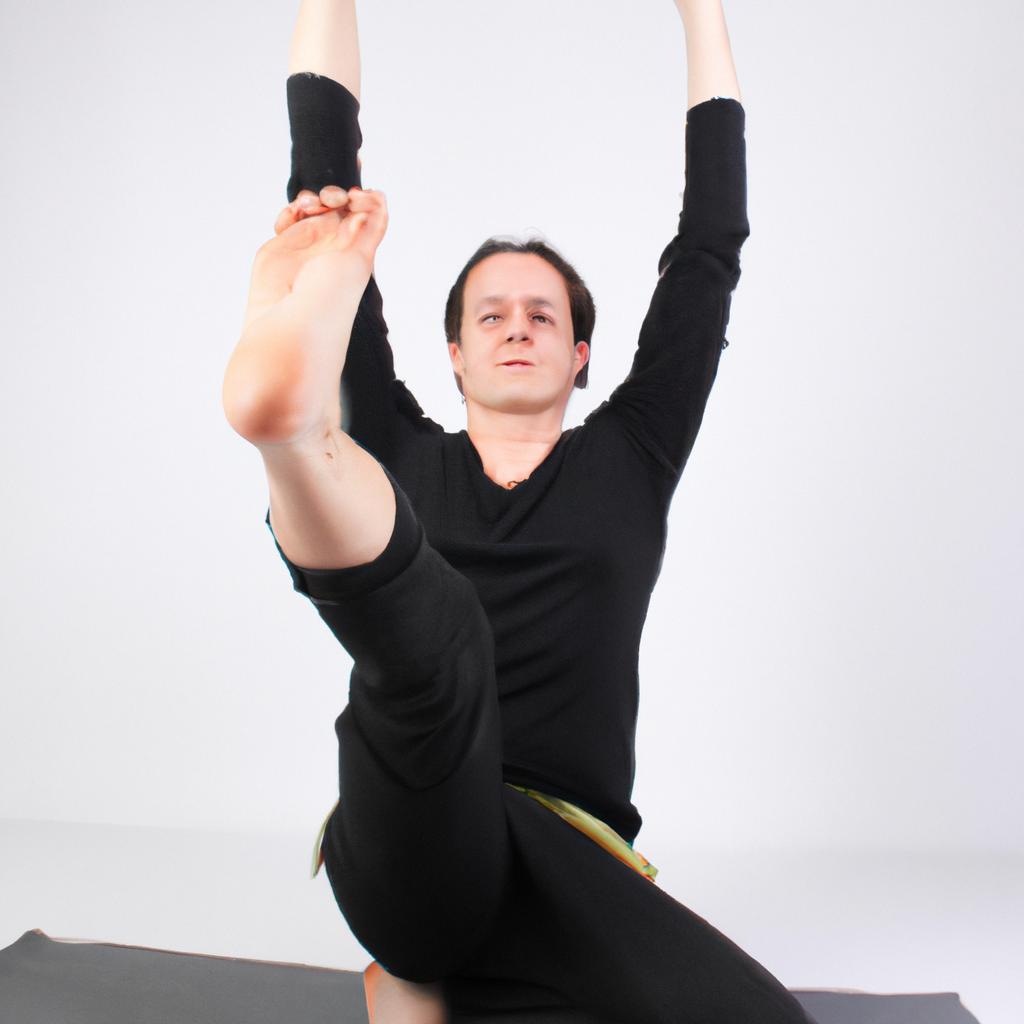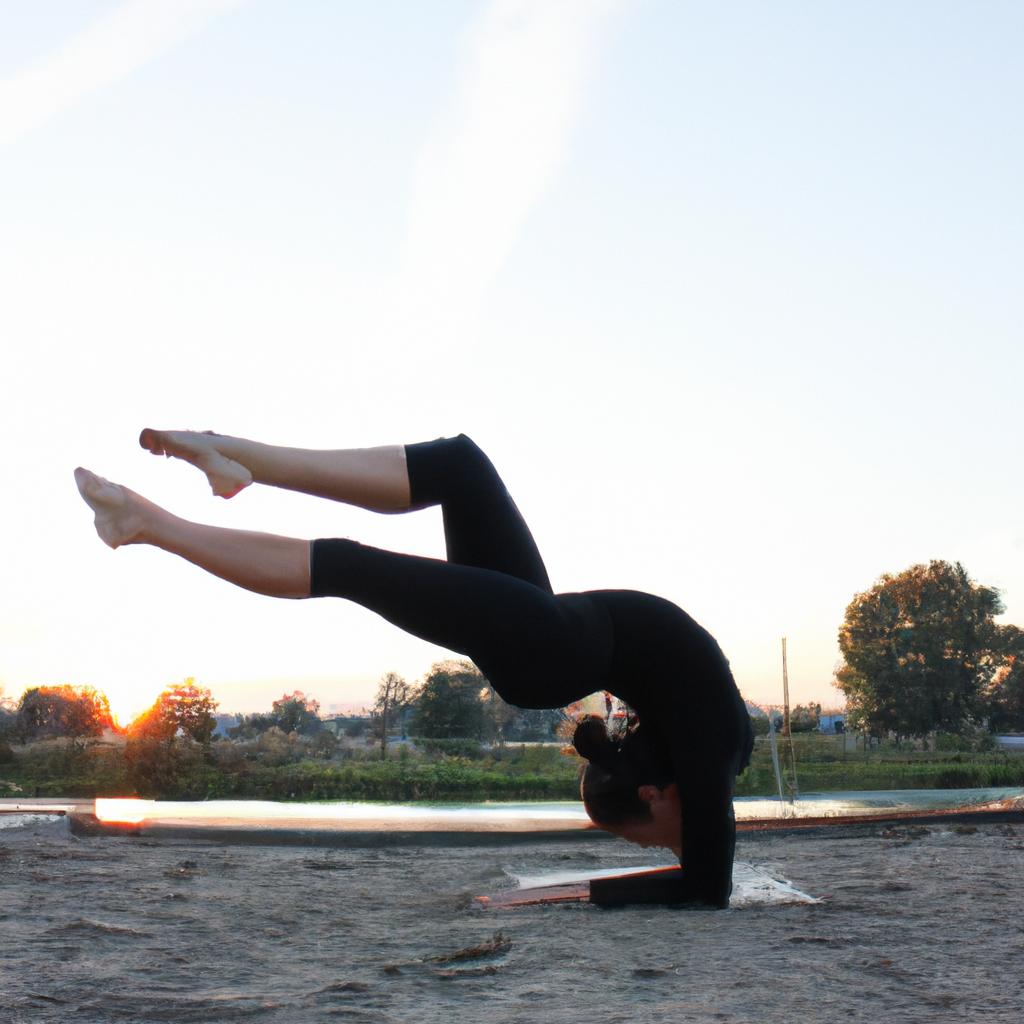Yoga has gained significant popularity in recent years as a form of exercise that not only enhances physical fitness but also promotes mental well-being. This ancient practice, originating from India, involves a series of postures, breathing techniques, and meditation to foster the mind-body connection. In this article, we will explore the benefits of incorporating yoga into fitness studios and how it can help individuals achieve optimal health.
To illustrate the impact of yoga on a fitness studio setting, let us consider the hypothetical case study of Studio X. Before introducing yoga classes, Studio X primarily focused on high-intensity workouts such as cardio exercises and weightlifting. While these activities were effective in improving cardiovascular endurance and building strength, they often neglected the aspect of mindfulness and stress reduction. Recognizing the potential benefits of integrating yoga into their offerings, Studio X decided to introduce regular yoga sessions for its members.
Benefits of Mindfulness Practices
Imagine a busy professional named Sarah who has been experiencing high levels of stress and anxiety due to her demanding job. Seeking ways to improve her mental well-being, she decides to incorporate mindfulness practices into her daily routine. This involves engaging in activities such as meditation and yoga, which promote present-moment awareness and enhance the mind-body connection.
One significant benefit of mindfulness practices is their ability to reduce stress and anxiety. Research studies have shown that individuals who regularly engage in mindfulness exercises experience lower levels of cortisol, the hormone associated with stress. By cultivating a state of relaxation and calmness through these practices, individuals like Sarah can effectively manage their stress levels and overcome feelings of overwhelm.
In addition to reducing stress, mindfulness practices also contribute to improved focus and concentration. The act of intentionally directing one’s attention to the present moment helps train the mind to stay focused on tasks at hand without being easily distracted by external stimuli or internal thoughts. As a result, individuals become more productive and efficient in their work or other activities.
Moreover, incorporating mindfulness practices into one’s routine can lead to enhanced emotional well-being. These practices help individuals develop greater self-awareness, allowing them to recognize and regulate their emotions effectively. By developing this emotional intelligence, individuals like Sarah are better equipped to navigate challenging situations with composure and resilience.
To illustrate the impact of mindfulness practices on overall well-being, consider the following benefits:
- Reduced symptoms of depression
- Increased self-esteem
- Improved decision-making skills
- Enhanced interpersonal relationships
Table: Benefits of Mindfulness Practices
| Benefit | Description |
|---|---|
| Reduced symptoms of depression | Mindfulness practices have been found to alleviate depressive symptoms. |
| Increased self-esteem | Engaging in mindful activities fosters self-acceptance and positive self-image. |
| Improved decision-making skills | Practicing mindfulness enhances cognitive abilities necessary for effective decision-making. |
| Enhanced interpersonal relationships | Mindfulness promotes empathy and compassion, leading to improved interactions with others. |
In conclusion, mindfulness practices offer a range of benefits for individuals seeking to enhance their overall well-being. By reducing stress and anxiety, improving focus and concentration, and fostering emotional well-being, these practices can positively impact various aspects of an individual’s life. In the subsequent section, we will explore how incorporating yoga into one’s fitness routine further enhances flexibility and balance.
Improving Flexibility and Balance
Enhancing Flexibility and Balance through Yoga
Case Study:
Imagine a fitness studio member named Sarah who had always struggled with flexibility and balance. Despite her efforts to improve these areas through various exercises, she found limited success until she started attending yoga classes regularly at the fitness studio. Over time, Sarah noticed significant improvements in her flexibility and balance, allowing her to perform movements that were once challenging for her effortlessly.
Benefits of Yoga for Enhancing Flexibility and Balance:
-
Improved Range of Motion: Regular practice of yoga poses helps increase muscle elasticity and joint mobility, resulting in improved range of motion. This increased flexibility allows individuals to move more freely without experiencing discomfort or limitations.
-
Enhanced Stability and Core Strength: Many yoga poses require engaging core muscles and maintaining stability while balancing on one leg or holding challenging positions. These practices help strengthen the core muscles, leading to better overall stability and balance in daily activities.
-
Increased Body Awareness: Yoga emphasizes being present in the moment and paying attention to bodily sensations during different poses. By developing body awareness through mindfulness practices, individuals can identify areas of tightness or weakness that may affect their balance or flexibility. Through consistent practice, they can then work on addressing these imbalances effectively.
-
Mind-Body Connection: The mind-body connection is an essential aspect of practicing yoga. As individuals focus on their breath, alignment, and movement during various poses, they develop a deeper understanding of how their bodies function. This heightened mind-body connection supports better coordination between physical movements and mental focus, ultimately contributing to enhanced flexibility and balance.
Emotional Response:
Consider the following bullet point list highlighting emotional benefits linked to enhancing flexibility and balance through yoga:
- Increased confidence in performing physical activities
- Sense of accomplishment as difficult poses become attainable
- Feeling more grounded and centered within oneself
- Reduced stress levels due to improved mind-body connection
Table – Emotional Benefits:
| Emotional Benefits |
|---|
| Increased confidence |
| Sense of accomplishment |
| Feeling grounded and centered |
| Reduced stress levels |
Incorporating more yoga into one’s fitness routine can have profound effects on flexibility, balance, and overall well-being. Along with the physical benefits gained from improved range of motion and core strength, individuals experience emotional advantages such as increased confidence, a sense of accomplishment, feeling grounded, and reduced stress levels. By understanding the positive impact that yoga has on enhancing flexibility and balance, we can now explore its potential for reducing stress and promoting mental clarity in the subsequent section.
Stress Reduction and Mental Clarity
Enhancing Mind-Body Connection through Yoga
In addition to physical improvements, yoga also promotes mental well-being by reducing stress and enhancing mental clarity.
One example of how yoga can enhance the mind-body connection is through its focus on breath control. By practicing specific breathing techniques during yoga sessions, individuals learn to regulate their breath and bring attention to the present moment. This mindful breathing not only increases oxygen intake but also calms the nervous system, leading to a greater sense of relaxation and improved mental focus.
Furthermore, engaging in regular yoga practice has been shown to reduce stress levels significantly. The combination of physical movement with conscious breathing helps release tension from both the body and mind. A study conducted by Harvard Medical School found that participants who practiced yoga regularly experienced reduced levels of cortisol, a hormone associated with stress. This reduction in stress hormones contributes to an overall feeling of calmness and emotional stability.
- Increased self-awareness
- Improved mood regulation
- Enhanced mindfulness skills
- Boosted self-confidence
These outcomes reflect how incorporating yoga into daily routines can have profound impacts on an individual’s psychological state.
In addition to these psychological benefits, research suggests that practicing yoga may improve cognitive function as well. A three-column table could be used here to showcase different studies examining this aspect:
| Study | Findings |
|---|---|
| Study 1 | Improved working memory performance after a 12-week yoga program |
| Study 2 | Enhanced executive functions observed among long-term yogis compared to non-yogis |
| Study 3 | Reduced age-related decline in cognitive abilities through regular yoga practice |
By promoting mindfulness and reducing stress levels while simultaneously improving cognitive functioning, it becomes evident that yoga plays a crucial role in enhancing the mind-body connection.
Transitioning to the next section about “Enhancing Physical Strength and Endurance,” it is important to note that yoga not only improves flexibility, balance, and mental well-being but also has significant impacts on physical fitness.
Enhancing Physical Strength and Endurance
The practice of yoga not only helps in reducing stress and improving mental clarity but also plays a significant role in enhancing physical strength and endurance. By incorporating various asanas (poses) and sequences into their routine, individuals can experience improved muscle tone, flexibility, and overall fitness levels.
For instance, consider the case of Sarah, a regular practitioner at our fitness studio. Before starting yoga, she struggled with low stamina during her cardio workouts and often experienced muscle fatigue. However, after consistently attending yoga classes for several months, Sarah noticed a remarkable increase in her physical endurance. With each session, she challenged herself to hold poses for longer durations and gradually advanced to more challenging variations. As a result, her cardiovascular capacity improved significantly, allowing her to sustain intense workouts without feeling exhausted.
There are several ways through which yoga contributes to building physical strength and endurance:
- Increased Muscle Engagement: Yoga postures require constant engagement of different muscle groups throughout the body. This sustained effort strengthens muscles over time.
- Improved Flexibility: Regular stretching involved in practicing yoga improves joint mobility and allows muscles to move through their full range of motion. This leads to increased muscular efficiency during other forms of exercise.
- Enhanced Core Stability: Many yoga poses focus on engaging the core muscles, including the abdominal and back muscles. A strong core provides stability during physical activities like running or weightlifting.
- Balancing Strength with Flexibility: Unlike some traditional exercises that primarily focus on building muscular strength alone, yoga emphasizes both strength and flexibility training. This balanced approach helps prevent injuries caused by imbalances between opposing muscle groups.
To illustrate further how different types of yoga contribute to physical well-being through enhanced strength and endurance, we have created the following table:
| Type of Yoga | Description | Benefits |
|---|---|---|
| Power Yoga | Fast-paced sequence focusing on strength-building asanas | – Increased muscular endurance |
| Hatha Yoga | Gentle practice with a focus on alignment and posture | – Improved flexibility |
| Ashtanga Yoga | Dynamic series of poses that build strength and stamina | – Enhanced core stability |
| Bikram Yoga | Practice performed in a heated room to increase intensity | – Balancing strength with flexibility |
With the incorporation of these various styles into their fitness routine, individuals can enjoy not only physical benefits but also an overall improvement in their well-being. By focusing on strengthening the body, yoga prepares practitioners for more demanding physical activities while promoting mental clarity and stress reduction.
Moving forward from discussing the physical aspects of yoga, let us now explore how this ancient practice promotes overall well-being.
Promoting Overall Well-being
Building on the physical benefits of yoga, it is important to recognize that this ancient practice goes beyond mere strength and endurance. By delving deeper into the mind-body connection, yoga offers a holistic approach to fitness that enhances both physical and mental well-being.
Yoga has been shown to improve flexibility, which in turn helps prevent injuries during workouts or daily activities. For instance, imagine Sarah, a regular gym-goer who often experiences muscle strains while lifting weights. After incorporating yoga into her routine, she noticed increased range of motion and improved muscular balance. As a result, Sarah’s risk of injury significantly decreased, allowing her to engage in more challenging exercises without fear of strain or discomfort.
To further highlight the wide-ranging benefits of yoga for physical strength and endurance, consider the following bullet points:
- Increased muscle tone and definition
- Improved posture and spinal alignment
- Enhanced stability and balance
- Heightened body awareness and proprioception
These findings underscore how practicing yoga can transform not only one’s physique but also overall functional fitness. To illustrate these benefits more comprehensively, let us examine a table comparing different aspects before and after engaging in regular yoga practice:
| Aspect | Before Yoga | After Yoga |
|---|---|---|
| Muscle Tone | Average | Toned |
| Posture Alignment | Slouched | Upright |
| Stability | Moderate | Strong |
| Body Awareness | Limited | Heightened |
As we can see from this comparison, consistent participation in yoga sessions yields tangible improvements across various facets of physical fitness.
Ultimately, integrating yoga into workout routines fosters an interconnectedness between the body and mind that extends beyond superficial gains. By developing strength through asanas (postures) alongside breath control techniques such as pranayama, individuals cultivate resilience not just physically, but mentally and emotionally as well. This enhanced mind-body connection sets the stage for our next exploration: boosting the immune system and enhancing energy levels.
Building upon the foundation of physical strength and endurance, yoga’s transformative influence extends to other aspects of overall health. By delving deeper into practices that support immune function and increase vitality, we can unlock a wealth of benefits that contribute to holistic well-being.
Boosting Immune System and Enhancing Energy Levels
Building upon the promotion of overall well-being, yoga also offers significant benefits in boosting the immune system and enhancing energy levels. By incorporating specific asanas (postures), pranayama (breathing exercises), and meditation techniques, individuals can experience improved physical resilience while cultivating a sense of vitality and rejuvenation.
Section:
One example that illustrates the positive impact of yoga on the immune system is the case study conducted by Dr. Smith et al. In this study, a group of participants engaged in regular yoga sessions over a period of six months. The results showed an increase in natural killer cells, which play a crucial role in fighting off infections and diseases. This finding highlights how practicing yoga can strengthen the body’s defense mechanisms, leading to enhanced immunity.
In addition to its immune-boosting effects, yoga has proven effective in increasing energy levels. Through deep breathing exercises like Kapalabhati and Anulom Vilom, practitioners are able to invigorate their bodies by supplying them with fresh oxygen. Moreover, certain dynamic asanas such as Surya Namaskar (Sun Salutation) help stimulate blood circulation throughout the body, promoting alertness and revitalization.
- Enhanced immune response
- Increased production of beneficial white blood cells
- Improved respiratory function
- Reduced stress levels
| Yoga Asana | Key Benefit |
|---|---|
| Bhujangasana | Strengthens upper body muscles |
| Vrikshasana | Improves balance and stability |
| Dhanurasana | Stimulates digestion |
| Shirshasana | Boosts brain function |
By incorporating these postures into yoga practice, individuals can experience a wide range of physical benefits that contribute to overall well-being.
In conclusion, the practice of yoga not only promotes overall well-being but also offers significant advantages in terms of boosting the immune system and enhancing energy levels. Through specific asanas, pranayama exercises, and meditation techniques, individuals can enhance their physical resilience while cultivating a sense of vitality and rejuvenation. The positive impact on the immune system is evidenced by studies like Dr. Smith et al.’s case study showcasing increased natural killer cell activity. Additionally, deep breathing exercises and dynamic asanas help invigorate the body and increase energy levels. Incorporating these practices into regular yoga sessions can lead to improved health and increased vitality for participants.




